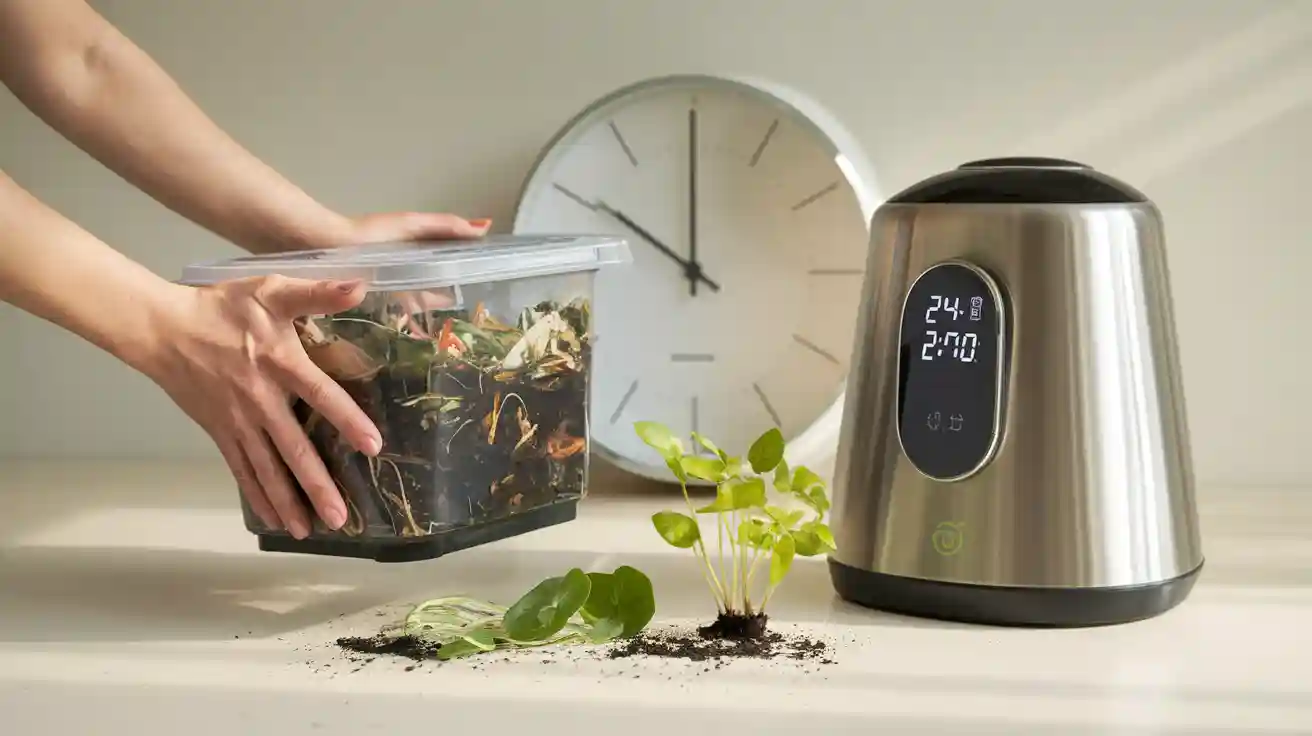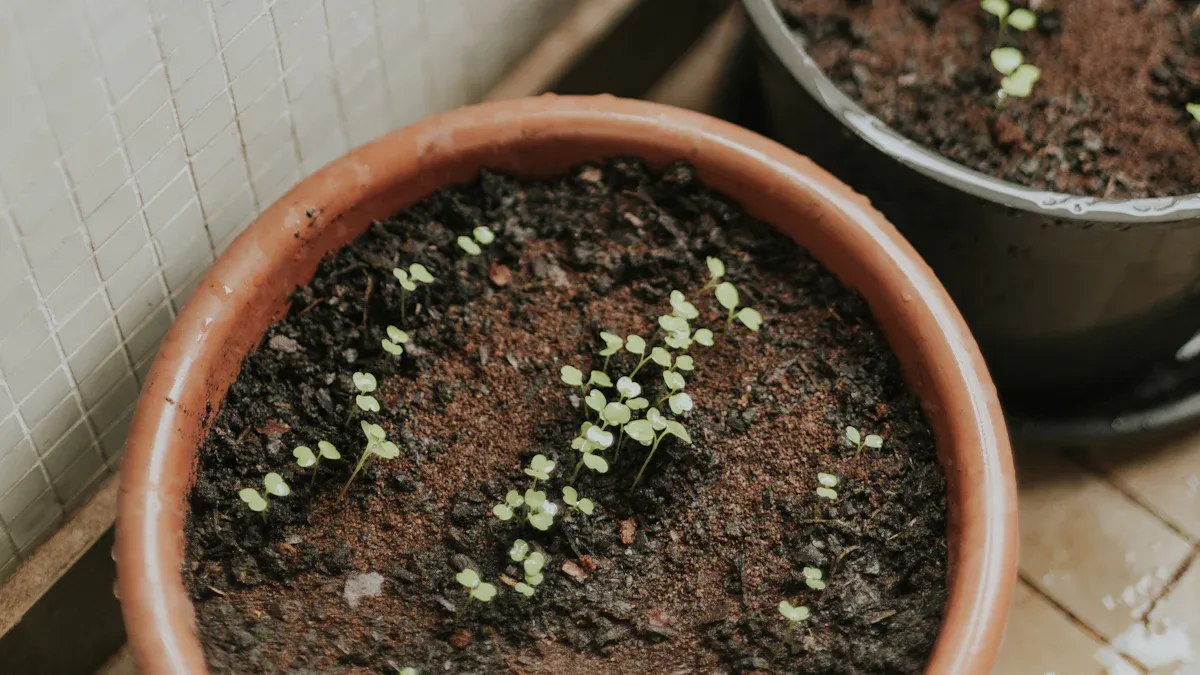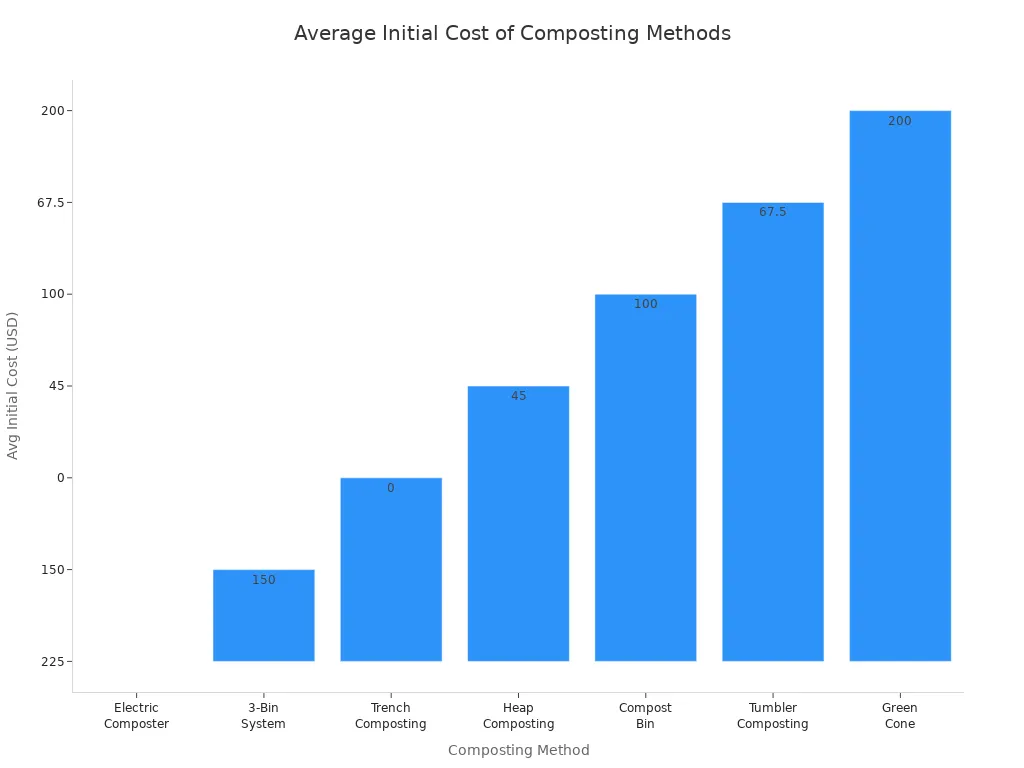
You may wonder if compost electric systems truly make compost in just 24 hours. Many electric composters process food scraps quickly, but their output often does not meet real compost standards. Industry experts note these machines usually make dehydrated material, not true compost, because composting needs microbial activity and time.
How Compost Electric Systems and Superfast Composting Methods Work
The 24-Hour Electric Composter Claim
You might see electric composters that promise to turn food scraps into compost in just 24 hours. These claims sound amazing, but scientists say they are not true. Dr. C N Manoj explains that no microbe can finish composting in one day. Dr. Sultan Ahmed Ismail also warns that these machines do not make real compost and could even harm your soil. Most electric composters only dry or heat your food scraps. They do not use the natural composting process that needs time and microbes. Some brands, like the Vitamix FoodCycler, admit they do not actually compost but only reduce the size of your kitchen scraps.
Dehydrators vs. Real Electric Composter with Microbial Action
Not all compost electric systems work the same way. Many electric composters act like dehydrators. They use high heat to dry out food scraps and kitchen scraps. This process kills microbes and does not start real composting. A real electric composter creates the right conditions for microbes to break down food. It controls temperature, moisture, and air. This helps microbes turn food into compost. Superfast composting methods, like hot composting or Bokashi, use special microbes or worms to speed up composting. These methods still need more than 24 hours to finish.
What Happens During Electric Composting
When you use an electric composter, the machine heats and grinds your food scraps. In most cases, the process only dries the scraps. Microbes do not have enough time to grow and break down the food. The output is a dry, sometimes charred material. It can have high salt and acid levels, which may hurt plants if you use it right away. You need to mix this material with soil and let it finish composting before it is safe for your garden. Real composting lowers salt and acid, keeps nutrients, and supports healthy soil. If you want to speed up composting, you need to give microbes time to work.
What You Get from an Electric Composter After 24 Hours

Is It Real Compost or Pre-Compost?
When you open your electric composter after 24 hours, you might expect to see dark, crumbly compost ready for your garden. In reality, what you get is not true compost. Most electric composters use heat, grinding, and air to dry and break down your food scraps quickly. This process does not allow microbes enough time to finish composting. The result is a dry, ground-up material that experts call “pre-compost” or “dehydrated food waste.”
Traditional composting takes months because it relies on natural microbes to break down waste slowly. This slow process creates nutrient-rich compost that helps your soil and plants. Electric composters work much faster, but their output is not biologically stable. It may contain high levels of salts and nutrients that can harm plants if you use it right away. The U.S. Environmental Protection Agency says the material from an electric composter is better described as a byproduct, not real compost.
Note: If you want to turn waste into garden gold, you need to let nature do its work. Electric composters give you a head start, but they do not finish the job.
Quality, Usability, and Garden Application
You may wonder if you can use the output from your electric composter directly in your garden. Horticultural experts say most electric composters, including popular brands like Lomi and Mill, do not make finished compost. Instead, they produce a dry, ground-up mix that needs more time to become safe and useful for your plants.
Here is a quick comparison:
| Feature | Electric Composter Output | Traditional Compost |
|---|---|---|
| Processing Time | 4-24 hours | Months to a year |
| Microbial Activity | Very low | High |
| Odor Control | Good | Varies |
| Plant Safety | Needs curing | Ready to use |
| Nutrient Stability | Unstable | Stable |
You can use the output as a soil amendment, but you should mix it with soil or add it to a compost pile. Some gardeners use it as an accelerator in traditional composting. If you apply it directly to your garden, you risk harming your plants because the material is not fully decomposed.
Tip: For best results, let the output cure in soil for at least a week before using it around your plants.
Does the Output Need Further Curing?
Almost all electric composter outputs need more time before they are safe for your garden. Scientific studies show that these materials are immature and unstable. They may contain substances that hurt plants, such as phytotoxins. Even after four weeks of curing, some outputs still show signs of being unfinished. If you use the material right away, you might see mold, attract pests, or even damage your plants.
You should always cure the output from your electric composter. Place it in your outdoor compost pile or mix it into garden soil and wait at least a week. This extra time allows microbes to finish breaking down the material. Only then will you have compost that is safe and helpful for your garden.
Alert: Skipping the curing step can lead to poor plant growth or even plant death. Always let your electric composter output finish composting before using it in your garden.
Are Electric Composting Systems Worth It?
Pros and Cons of Electric Composters vs. Traditional Methods
When you compare electric composters to traditional composting, you see many differences. Electric composters work fast and fit well in your kitchen. You do not need to turn piles or worry about pests. These machines control odors and let you compost food scraps indoors, even in cold weather. You can use them year-round, and they handle most food waste, including some items that traditional compost bins cannot process.
However, electric composters cost more at the start. You pay for the machine and must replace filters every few months. They also use electricity, which adds to your bills. Some models make noise and take up space in your kitchen. The output is not finished compost, so you need to cure it before using it in your garden. Traditional composting takes longer and needs outdoor space, but it costs less and gives you rich compost for your garden.
| Composting Method | Average Initial Cost | Maintenance Requirements | Notes on Operation and Limitations |
|---|---|---|---|
| Electric Composter/Food Recycler | $150 – $300 | Filter replacement every 3-4 months ($45-$50), uses energy, minimal manual labor | Operates year-round, breaks down all food waste including bones and dairy, produces dry powder-like material, faster (5-24 hours) |
| Compost Bin Method | $50 – $150 | Manual turning required, outdoor space needed | Suitable for small yards, slower composting (3 months to 1 year), no bones/meat/dairy allowed |

Tip: Electric composters work best for people with little space or those who want quick results from composting food scraps.
What Materials Can Go in an Electric Composter
You can put many types of food scraps in an electric composter. Most machines accept fruits, vegetables, bread, pasta, rice, and even coffee filters or paper. Some kitchen composter models can handle meat, bones, and dairy, but always check your manual. Avoid putting citrus, onions, garlic, oils, and seasoned foods in worm-based electric composters. These items can harm the composting process or damage the machine. If you use a traditional compost bin, you should not add meat, bones, or dairy because they attract pests.
Energy Use and Environmental Impact
Electric composters use energy to heat, mix, and dry your food scraps. Each cycle adds to your electricity bill and increases greenhouse gas emissions, especially if your power comes from non-renewable sources. On average, electric composting uses over 500 kWh per ton of food waste. This process can release up to 197 kg of CO2 for each ton of dry solids. Traditional composting does not use electricity, so it often has a lower environmental impact. However, it can still release methane and nitrous oxide if not managed well. Improvements in compost bin design and composting methods can help reduce these gases. Right now, electric composters do not offer a clear environmental advantage over traditional composting.
You now know electric composters do not make true compost in 24 hours. You get pre-compost, not finished compost. If you want fast results and have little space, these machines help. For rich compost, you should let microbes finish the job outdoors or in soil.
FAQ
Can you use electric composter output right away in your garden?
You should not use the output right away. Mix it with soil or let it cure. This keeps your plants safe and healthy.
What is the difference between electric composters and home composting bins?
Electric composters work fast and fit indoors. Home composting bins use microbes and take longer. Both help you learn how to compost at home.
Do electric composters smell bad in the kitchen?
Most electric composters control odors well. You can use them indoors without worrying about bad smells from food scraps.


